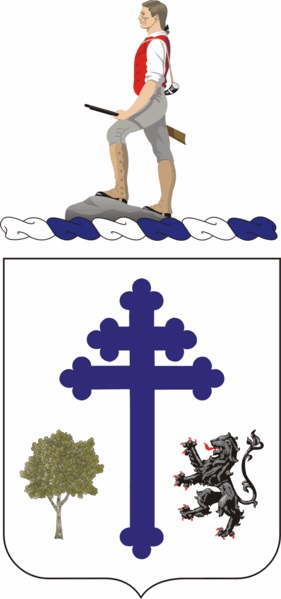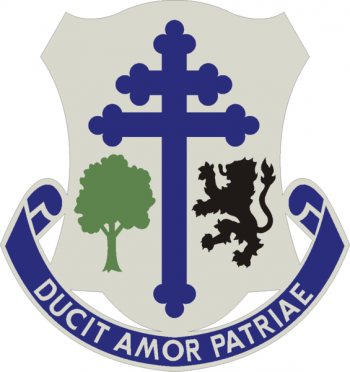361st (Infantry) Regiment, US Army: Difference between revisions
Knorrepoes (talk | contribs) m (Text replacement - " Lorraine" to " Lorraine") |
Knorrepoes (talk | contribs) m (Text replacement - "Category: " to "Category:") |
||
| (8 intermediate revisions by the same user not shown) | |||
| Line 1: | Line 1: | ||
''' {{uc:{{PAGENAME}}}} ''' | ''' {{uc:{{PAGENAME}}}} ''' | ||
{|align="center" | {|align="center" | ||
|align="center"|[[File:{{PAGENAME}}.jpg|center|350 px|Coat of arms (crest) of {{PAGENAME}}]] <br> (Coat of Arms) | |||
|align="center"|[[File:{{PAGENAME}}dui.png|center|350 px|Coat of arms (crest) of {{PAGENAME}}]]<br> (Distinctive Unit Insignia) | |||
|align="center"|[[File:{{PAGENAME}}dui.png|center|350 px| | |||
|} | |} | ||
| Line 24: | Line 21: | ||
Blue and white are the colors used for Infantry, the original designation of the unit. The three battle honors awarded the organization for services during World War I are symbolized by the patriarchal cross, which represents [[Lorraine]], where the regiment first entered combat in 1918; the oak tree which alludes to the woods of Meuse-Argonne, the general area of operation in France; and the lion, taken from the arms of Belgium, which represents the Ypres-Lys campaign in 1918. | Blue and white are the colors used for Infantry, the original designation of the unit. The three battle honors awarded the organization for services during World War I are symbolized by the patriarchal cross, which represents [[Lorraine]], where the regiment first entered combat in 1918; the oak tree which alludes to the woods of Meuse-Argonne, the general area of operation in France; and the lion, taken from the arms of Belgium, which represents the Ypres-Lys campaign in 1918. | ||
The | The arms were originally authorized for the 361st Infantry Regiment on 19 April 1924. It was redesignated for the 361st Regiment on 24 January 1962. The Distinctive Unit Insignia was originally authorized for the 361st Infantry Regiment on 8 March 1927. It was redesignated for the 361st Regiment on 24 January 1962. | ||
[[Literature]]: Images from Wikimedia Commons. Information from The Institute of Heraldry, US Army. | [[Literature]]: Images from Wikimedia Commons. Information from The Institute of Heraldry, US Army. | ||
[[Category:Military heraldry of the United States]] | [[Category:Military heraldry of the United States]] | ||
[[Category:Army heraldry]] | [[Category:Army heraldry]] | ||
[[Category: Granted 1924]] | [[Category:Granted 1924]] | ||
[[Category: Granted 1927]] | [[Category:Granted 1927]] | ||
Latest revision as of 09:12, 15 October 2023
361ST (INFANTRY) REGIMENT, US ARMY
| (Coat of Arms) |
(Distinctive Unit Insignia) |
Official blazon
Shield: Argent, a patriarchal cross botonny Azure between in fess debased an oak tree Vert and a lion rampant Sable.
Crest: That for regiments and separate battalions of the Army Reserve: From a wreath Argent and Azure, The Lexington Minute man Proper. The statue of the Minute Man Proper. The statue of the Minute Man, Captain John Parker (H.H. Kitson, sculptor), stands on the common in Lexington, Massachusetts.
Motto: DUCIT AMOR PATRIAE (Led by Love of Country).
Distinctive Unit Insignia. Description: A Silver metal and enamel device 1 1/8 inches (2.86 cm) in height consisting of a shield blazoned: Argent, a patriarchal cross botonny Azure between in fess debased an oak tree Vert and a lion rampant Sable. Attached below and on the sides of the shield, a Blue scroll inscribed "DUCIT AMOR PATRIAE" in Silver letters.
Origin/meaning
Blue and white are the colors used for Infantry, the original designation of the unit. The three battle honors awarded the organization for services during World War I are symbolized by the patriarchal cross, which represents Lorraine, where the regiment first entered combat in 1918; the oak tree which alludes to the woods of Meuse-Argonne, the general area of operation in France; and the lion, taken from the arms of Belgium, which represents the Ypres-Lys campaign in 1918.
The arms were originally authorized for the 361st Infantry Regiment on 19 April 1924. It was redesignated for the 361st Regiment on 24 January 1962. The Distinctive Unit Insignia was originally authorized for the 361st Infantry Regiment on 8 March 1927. It was redesignated for the 361st Regiment on 24 January 1962. Literature: Images from Wikimedia Commons. Information from The Institute of Heraldry, US Army.

